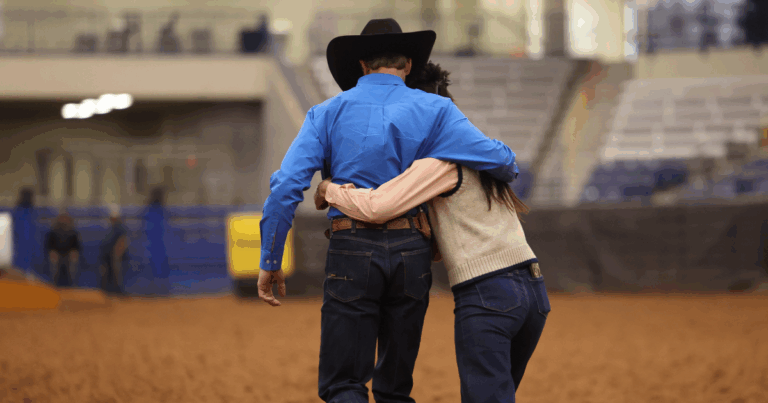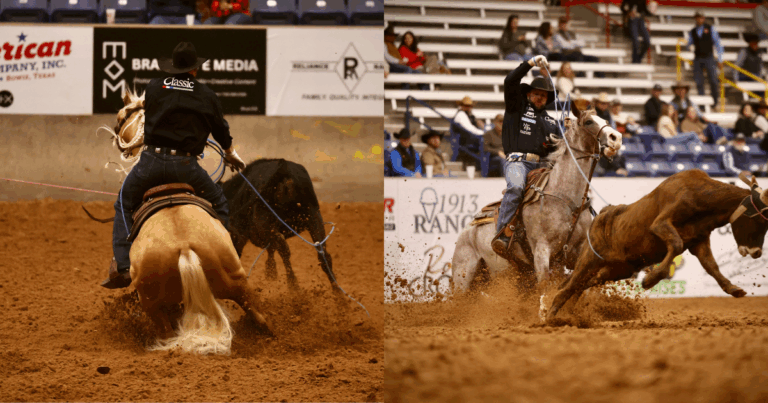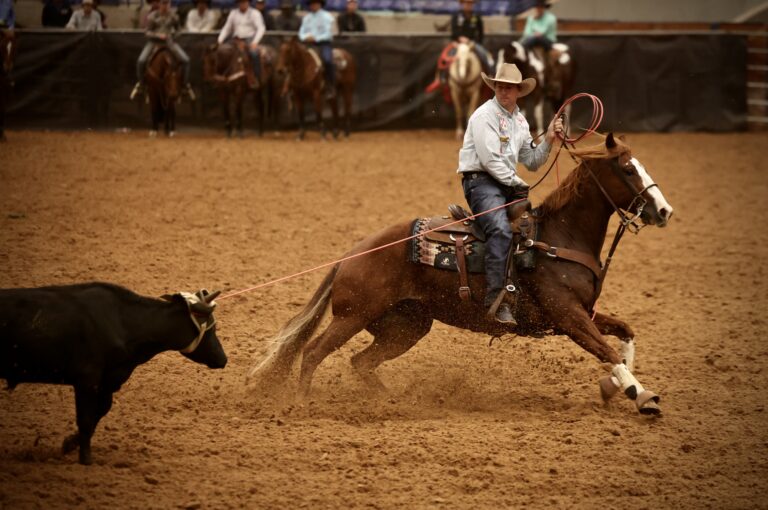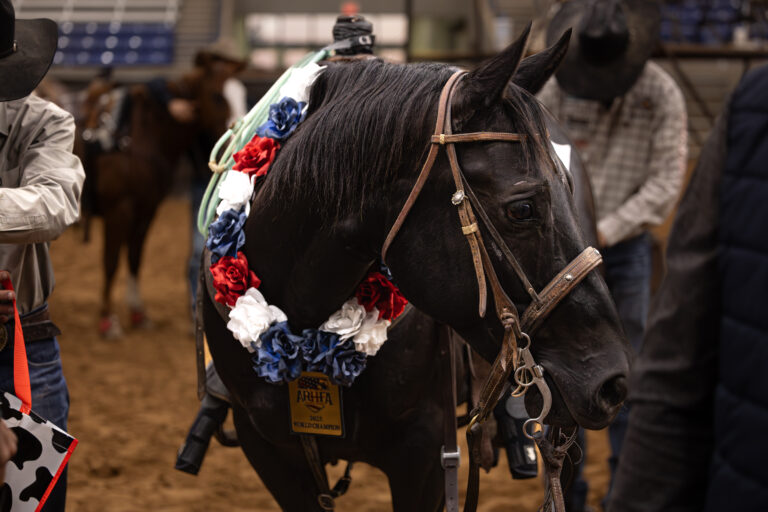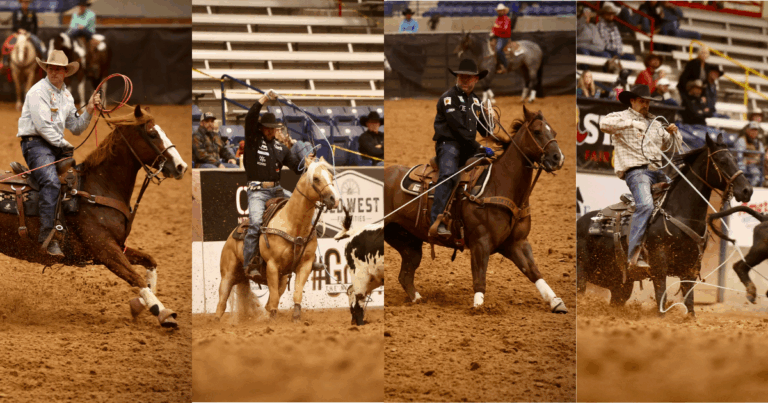Rodeo fans are accustomed to seeing three-time National Finals Rodeo qualifier Dakota Kirchenschlager riding the perfect position to execute masterful heel shots with uncanny ease. What’s less expected, at least until fairly recently, is seeing the Whitesboro, Texas, rope horse trainer changing leads and running down to sliding stops and fast spins (yeah, different spins) in National Reined Cow Horse Association sanctioned competition. But this fall, you may very well catch him entered up in the American Rope Horse Association World Championships, held in conjunction with the Snaffle Bit Futurity, as well as in the futurity or horse show itself.
“Our rope horses have to run; they have to stop and they have to cow,” he said. “It’s actually a lot like what you need them to do if you’re looking for a snaffle bit-er. I like the crossover because the reined cow horses, they’ve been hauled, they’ve been prepared to show, they are very broke and that’s exactly how we need them to be as rope horses. When you look at the top level in the cow horse deal, those horses are really broke. We need all that, too.”
[Shop: Dakota Kirchenschlager’s Fast Back Gear]
Fast Back Ropes Natural Heel Rope
(As an Amazon Associate, we earn from qualifying purchases made through affiliate links.)
Kirchenschlager earned big-time recognition early in his roping career as the 2011 Resistol Team Roping Rookie of the Year in heeling. The phenom quickly ascended the elite ranks to make his first appearance at the NFR at age 21, in 2012. He returned to Vegas in 2014 and 2016, and has won the most coveted titles in the business—among them, Cheyenne Frontier Days in 2016 heeling for Tyler Wade; the first two rounds of the 2014 NFR behind Turtle Powell; Guymon; Odessa; Pecos—the list goes on. But after finishing 50 in the 2017 heeling standings, Kirchenschlager’s competitive focus shifted.
With the rope horse market strong, and futurities being a great atmosphere for exposing young horses to competition, Kirchenschlager has found his niche in training, more than traveling to rodeos. His training philosophy relies on lessons learned from reiners, reined cow horse trainers and ropers alike, and he stresses the importance of keeping horses responsive and liking their job.
“I see a lot of people who never do get a horse soft; they only rope on them,” he said. “A horse is not going to put out 110% if you just rope and don’t put in the time of keeping them together, keeping them relaxed.”
Avoiding burnout is a big deal in Kirchenschlager’s training routine, and particularly important to longevity of rope horses that will hopefully have many competitive years beyond their futurity season ahead of them.
“They get burnt out, just like a person. If you take your kid to basketball and they come home and say, ‘My coach just yelled at me the whole time. I don’t really care if I go back,’ it’s the same with horses,” he said. “They’ve got to like what they do. You can’t mash it out of them everyday. It takes a lot of time. The set of horses I’ve got right now, I’ve had for several months and they’ve got a good rhythm to where the expectations are simple to understand.”
A lot of the horses in his program are 5- and 6-year-olds that have previously been reined on, so Kirchenschlager introduces them to tracking and rating cattle gradually.
“We’ll work a cow on them when we get them and by exposing them to that then, when we start roping on them, they guide easier because they’ve learned to correlate when you position them to their position on a cow.”
In certain cases, crossover between events makes good sense in Kirchenschlager’s program. Taking a snaffle bit-er or derby horse, for instance, and transitioning it into the roping pen is one such scenario.
“If they’re broke enough to do a respectable reining pattern and broke enough to take a cow down the fence respectably, I feel that the roping should come pretty easy for most of them. It makes for a natural crossover,” he said.
While his rope horses are expected to track cattle and drag their butts, it’s obviously not to the extent of what is demanded in a reining pattern.
“We’ll run and stop one, but not necessarily fencing them like a reiner would,” he said. “The end goal, for what we’re doing, is for them to run hard, rate a cow and stop hard. So if we’ve asked them to stop big a few times and got them soft, odds are pretty good that when we back into the box and go rope one, that should be pretty easy for them to navigate.”
To keep his horses liking their jobs, Kirchenschlager’s goal is simplicity in his training routine.
“Sometimes we just lope long straight lines back and forth down the arena, kind of like if you were a reiner fencing one, but we don’t stop them much,” he said. “I think things need to stay simple and relaxed for them.”
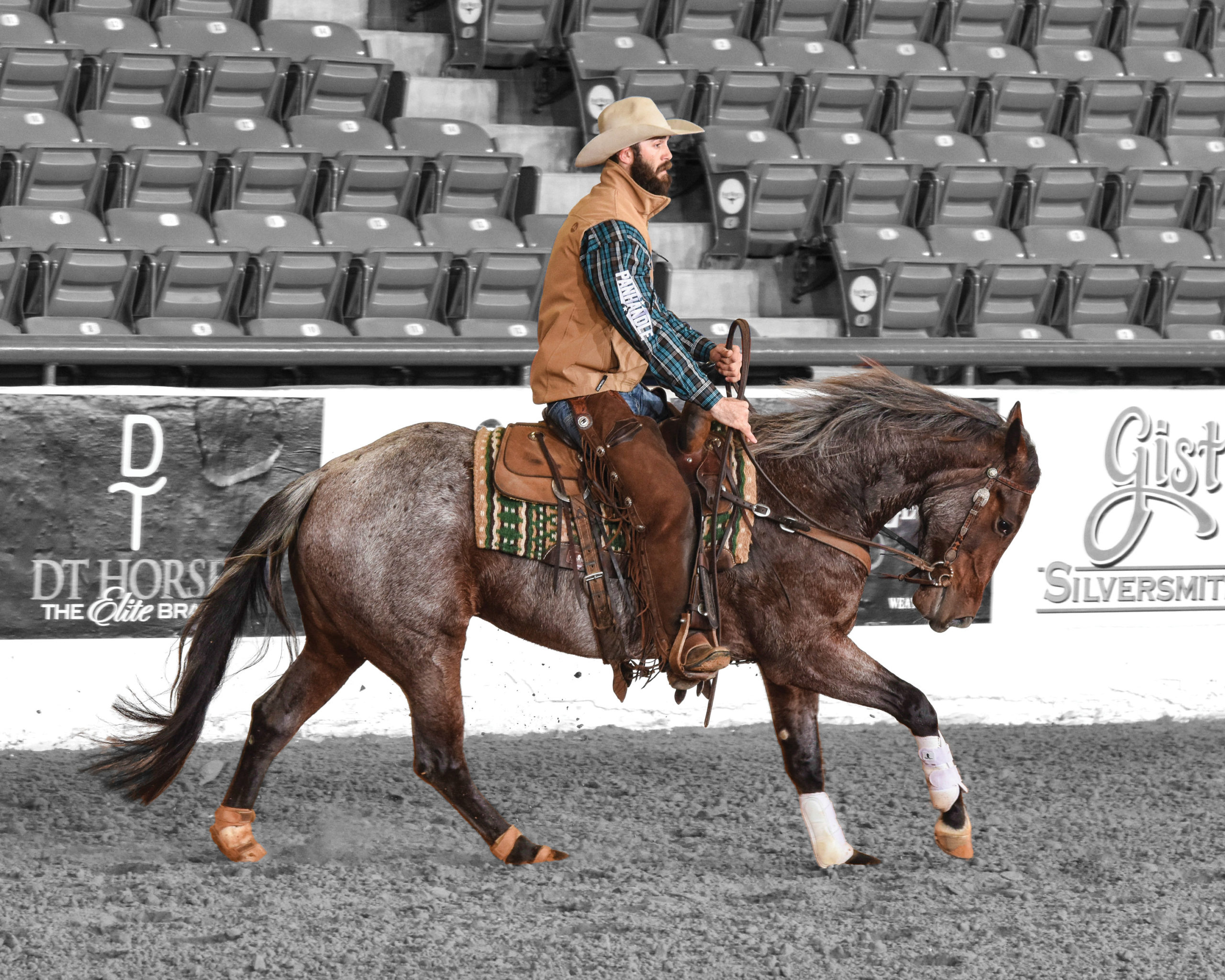
Relying on Routine
Kirchenschlager aims to structure his workweek by accomplishing various objectives for the horses each day.
“Mondays we spend just getting the horses out and trotting them,” he said. “We’ll trot and lope them with no tie-down; just get them soft in the face with a ring bit or not a lot of bit on them; just get them out, breaking them at the poll; get them supple and responsive, just keeping things relaxed.”
Tuesday’s routine closely resembles what he does on Mondays, but Kirchenschlager says he likes to add in some breakaway roping or tracking a really slow steer to work on fundamentals at an easy pace. “The goal with that is keeping them soft and moving off my hands and my legs,” he added.
“Wednesdays, I rope, but what I think about is, at these rope horse futurities, you’ve got to make three or four solid runs; so if I can make a habit of making four nice, smooth runs on them, keeping everything easy, that’s what I want to do.”
Thursdays are typically devoted to working on any issues that need to be addressed.
“Say, if a horse was bad in the box or something, we’d score, maybe not even rope anything,” he said. “You cannot train these horses like it’s a factory. It will not work. So, we keep in mind that each one’s different and each one needs a little different approach.
“Friday, I might make one run on one horse, or I might make four on another; it just depends on the individual and what they need,” he said. “Like today, we got 10 of them out to trot and lope and roped on another seven of them.”
Attention to detail is another cornerstone to Kirchenschlager’s training philosophy.
“There are so many little details that can make a difference for a horse,” he said. “Sliders, as an example: You might need to put a little less slider on one to help his confidence, or put a little more aggressive slider in another case where the horse needs a little help going to the ground. It always depends on what’s best for each horse.”
Kirchenschlager says he’s gained valuable pieces of knowledge from different influences to come up with his own approach. Riding with AQHA professional horsemen Robbie Schroeder and Gary Wells, Shawn Darnall and NRCHA professional Brad Lund has helped his learning curve immensely.
“Also Matt Armenta and Ronnie Thompson have both been a huge help to me with my reined work,” Kirchenschlager said. “Brad taught me how to show. I’d have to say Robbie and Shawn really taught me how to train. Gary, he taught me all the little things. He could tell me something in one word that would be the most impactful thing, and I consider him to be one of the most underrated horse trainers out there. I’m fortunate to know all of them.”
Always looking for a challenge and chance to learn, Kirchenschlager has found both in the horse show world. As to what he considers to be the most difficult aspect of NRCHA competition for him, he says it’s the reined work.
“Showing, the reining is definitely the hardest. I mean it’s all hard, but you’ve got to remember the patterns and make all the markers, or you get a zero or significantly lower score,” he explained. “It’s easy to sit there at home and tell your buddy, ‘I could do that; that doesn’t look too tough,’ but I promise you, it’s not an easy task. You’ve got to present each maneuver perfectly and set things up for your run. Doing that right takes showmanship because, even if things feel a little off when you’re out there, you can’t let the judges know. You’ve got to bring some showmanship to it.”
Kirchenschlager’s future goals are big and varied, but not beyond reach.
“Someday I’d love to have a horse I trained win the NRCHA World’s Greatest Horseman. I’d love to win the Snaffle Bit or a major derby,” he said. “Of course, success with the roping futurities is always my goal. I’d like to show one at the NCHA Futurity, too. I’ve always wanted to show at all the futurities of different disciplines. Anything to do with horses at a young age, training them, it takes a special person and I like being around that. I’m always wanting to learn. I really enjoy the mindset of trainers. No matter the ups and downs, that mentality of helping each other and giving back, that’s very cool.”
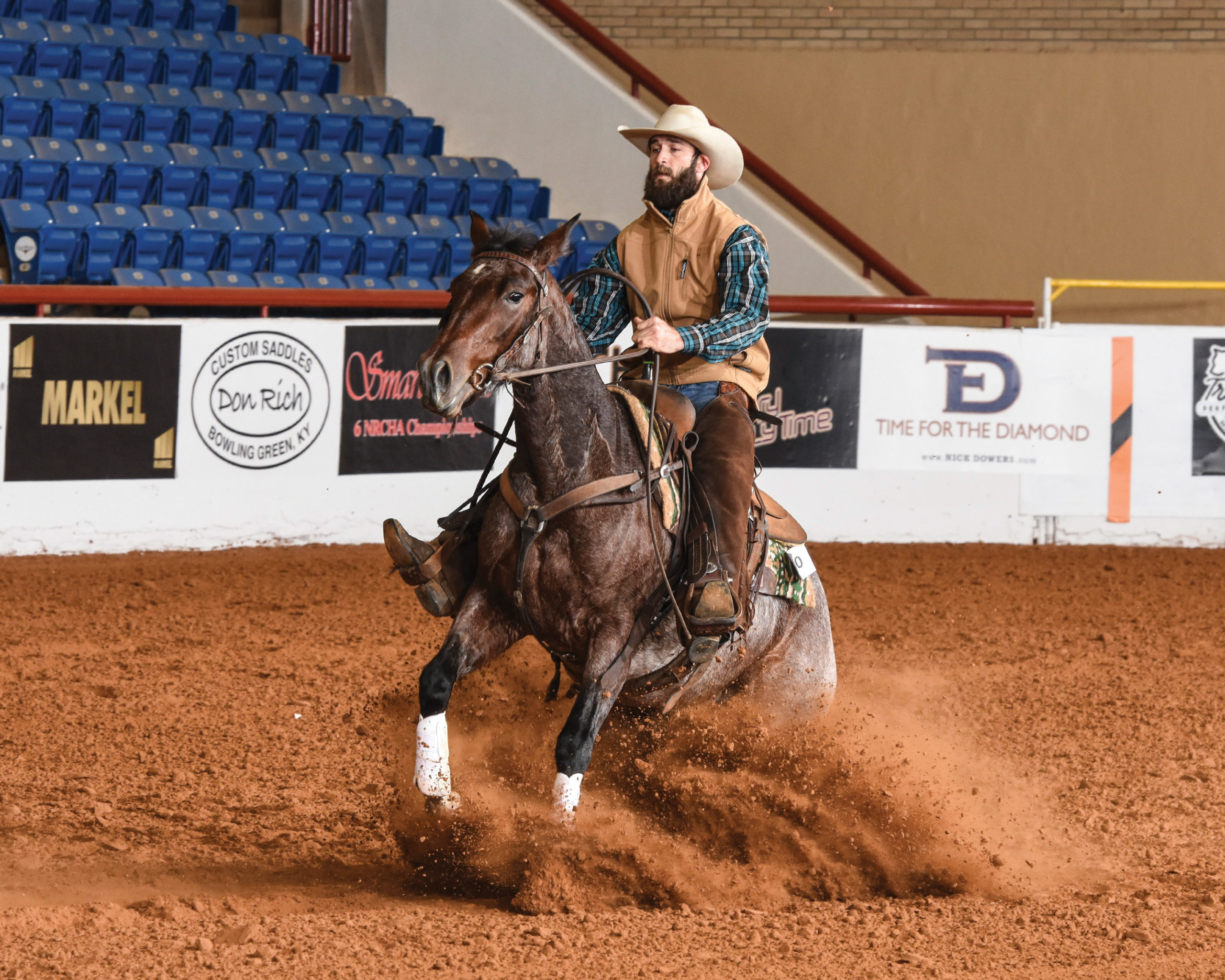 Kirchenschlager rode Nirvanna, by Metallic Cat and out of the mare Reycherche, for Clay and Kelsey Johnson at the 2019 Tres Osos Cow Horse Derby. undefined
Kirchenschlager rode Nirvanna, by Metallic Cat and out of the mare Reycherche, for Clay and Kelsey Johnson at the 2019 Tres Osos Cow Horse Derby. undefinedIn the Blood
As for preferred pedigrees, Kirchenschlager does favor rope horse prospects that are bred to have some cow.
“We’ve had some Metallic Cats, Dual Reys. This year, we’ve had a few Gunnatrashyas,” he said. “I’ve got a One Time Royalty that I really like. I’ve got two Shine On Line mares that I like an awful lot.”
Shine On Line is a 2006 red roan stallion by Shining Spark and out of the Doc’s Oak mare, Oaks Little Diamond, herself a snaffle bit futurity champion with more than $10,000 in NRCHA earnings.
“The Shine On Line horses are very good minded. They cinch deeper and they’re really strong. The ones I’ve had have had no soundness issues whatsoever,” Kirchenschlager said.
Shine On Line sired the 2014 mare, Hangin On The Line (“Gunny”), that Kirchenschlager rode for Armenta Quarter Horses to $19,000 in earnings for first in the 4-year-old Heeling Incentive and fourth in the Open Heeling at the 2018 ARHFA World Championships in Fort Worth, Texas. Gunny is out of the Spooks Gotta Gun daughter, Spooks Hangten. When Kirchenschlager spent the latter part of 2019 sidelined with a broken leg, his cousin Trevor rode Gunny as a 5-year-old in the ARHFA event to finish fourth in the Open Heeling for $14,000.
Spoonful Of Comfort (Hes A Peptospoonful x Jewel Bar Ruby x Lenas Jewel Bars), owned by Marty Yates, placed 10th in the Open Heading and sixth in the Open Heeling with Kirchenschlager at the 2018 ARHFA World Championships and, after resting him his 7-year-old year, Kirchenschlager says you might see Yates heading on the horse at a few rodeos this year.
Dakota Kirchenschlager’s Top 3 Fundamentals
Slow down & check for softness
“The biggest deal to me is that, every day, you’ve got to slow things down and check for softness. I make sure my horses are responsive to pressure from my legs and that they’re staying soft between the bridle reins. If not, it doesn’t make sense to rope until you’ve got that softness because you will not have long-term success unless you do. I want a horse to work from age 3 to 15, and that’s why I’ve got to have them broke and soft. You’ve got to maintain that every day you ride them.”
Go both ways
“A lot of times, I see people that trot and lope mostly to the left. It’s just something most all of us have the tendency to do. I make a point to trot to the right a lot and go both ways—to the point that, even when I catch one and lead it out of the stall, I think about going to the right when I’m leading them. You’ve got to work your horse both ways for muscle memory and soundness. You hear a lot of good horsemen say, ‘Work both sides,’ and it’s true.”
Know your horse
“I’ve got to know my horses enough to know when something’s a little off. I’ll flex their head side to side, for example, and if I’ve got one not wanting to give its face one way and he’s normally a pretty supple, responsive type horse, there might be a little something cropping up. I feel like horses will kind of take care of themselves if you keep up on the worming, the EPM, parasites, good nutrition—all the basics—but make sure you know your horse well enough to know when something’s not quite right and get it checked out.”





